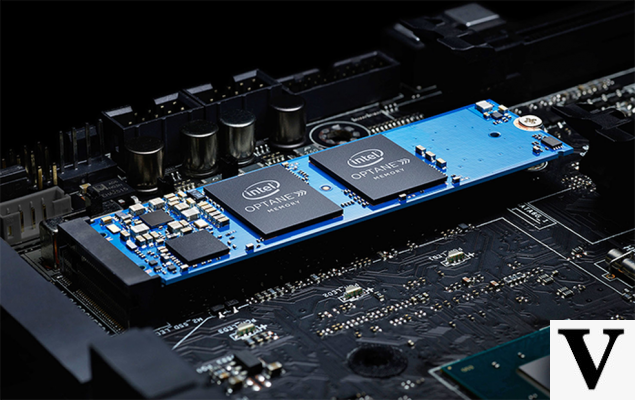
Intel Optane Memory it is difficult to label. It is not a RAM - even though it resembles a memory bank - and it is not an SSD either, although the speed is similar to that of an NVMe solid state drive.
So what exactly is it? Don't panic, I'm here to explain it to you. But before we help you understand how Intel Optane Memory works, let's start with a key concept: this absolutely peculiar product was created with the aim of speeding up the classic daily operations. In short, if you are tired of waiting for the opening of programs, files, games or even for the start of your PC, Intel Optane Memory can help you.
What is Intel Optane?
First of all, know that Intel Optane is the name of a technology that can be applied to two different products: SSDs and Intel Optane Memory. We will focus on the latter, ie on a memory that, as I mentioned before, is neither a RAM nor a hard disk but combines typical characteristics of both components.
Its purpose is to speed up the computer by behaving like a cache for SSD or HDD. All this to allow you to quickly access the data you usually recall and thus speed up daily operations.
Intel Optane Memory: How to Install?
At this point you will ask how to install this magical component invented by Intel. In reality, you don't have to do it: there are both desktop and laptop PCs that already integrate Intel Optane technology, a parameter that you could consider when buying your next computer.
Those who already own a PC can purchase Intel Optane memory and mount it. But be careful, you have to make sure you have everything you need:
- an Intel Optane certified motherboard with M.2 slot
- an Intel Kaby Lake processor generation seventh or later
- Windows 10
Once this component is mounted, you will of course have to start the computer and install the dedicated software, that is Intel Rapid Storage Technology. The latter will act as a driver and will allow you, if necessary, to disable Intel Optane Memory.
But what exactly does it do?
In summary: this innovative technology can be present on desktop and notebook PCs and acts as a cache so as to speed up those operations that we usually perform on the computer.
But how does he do all this? Intel Optane Memory uses a series of algorithms to analyze your usual behavior and understand which data you recall most during the day. The latter will then come stored in memory permanently, memory that will have the priority both on the hard disk and on the eventual SSD.
All this happens automatically, without requiring any kind of intervention on your part, and allows you to speed up all kinds of activities.
But no more chatter! To make you understand how much Intel Optane Memory can affect the performance of a computer we decided to make a series of experiments using two different terminals: an Acer Swift 3 laptop and an HP Pavilion 595 desktop PC.
Who is it suitable for and how much it costs
Intel Optane Memory is suitable practically to all those who manage large files, heavy software and games of any kind.
Worried about the costs? You can sleep peacefully: the price of the variant from 16 GB stands around the 40-50 euro, while that from 32 GB arrives at 60-70 euro. A very small investment that will help you save time and reduce the frustration generated by your PC.
[amazon_link asins=’B06XSXX3NS,B06XSMTN31,B07776HSPW’ template=’ProductCarousel’ store=’gamspri02-21′ marketplace=’IT’ link_id=’a73805ba-52df-4367-9632-cde6ae4e3539′] TagsIntel Intel Optane Memory Intel Optane Memory: Is Your PC Faster?



















![[Review] Samsung Powerbot VR7000: the robot vacuum cleaner from Star Wars](/images/posts/6bc44de38605b5c0fa12661febb1f8af-0.jpg)





